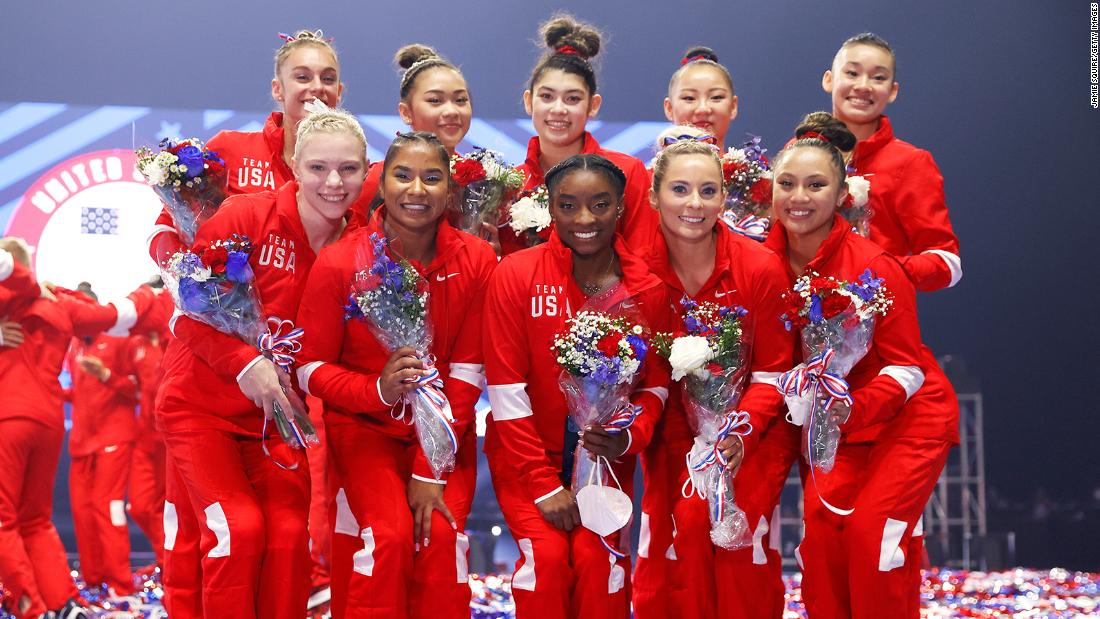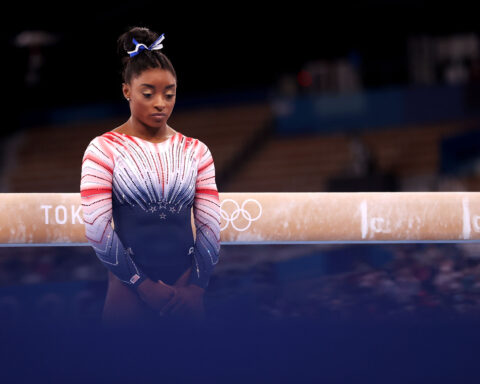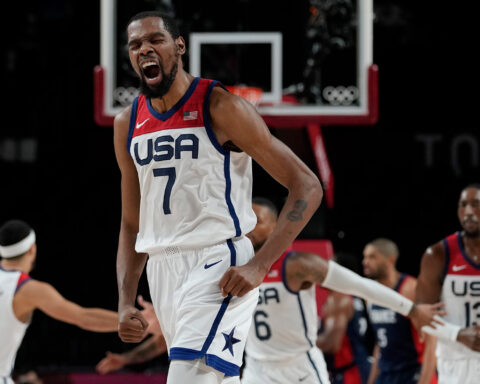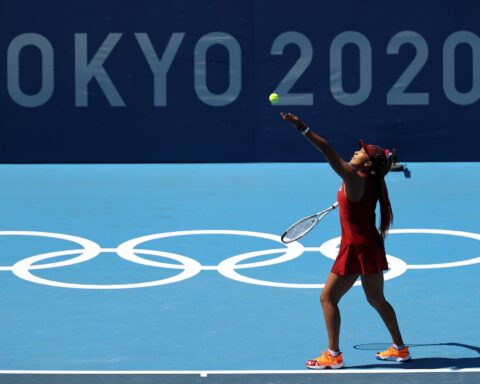When it comes to sports that attract fervent attention at the Olympics, gymnastics is always a top contender. Pulse-pounding and entertaining, the gravity-defying skills exhibited by athletes is unlike anything else seen at the Games. However, thanks to the Covid-19 pandemic erasing a year of anticipation-building pre-Olympic competition, there is also an air of mystery for those outside the gymnastics universe about most of the six women — alongside stalwart Simone Biles, there’s Jordan Chiles, Sunisa Lee, Grace McCallum, Jade Carey and MyKayla Skinner. Some — like Chiles, whose prospects were bolstered after a move to Biles’ gym — are underdogs, and some — like Skinner, who stepped away from a star spot on the University of Utah’s team to train for an Olympics berth — are stepping outside the conventional path for the sport.
For any aspiring elite gymnast, the Olympics are still everything. But up until these Games the definition of “everything” also included the pressure to turn professional, to capitalize as much as possible on the potential for money-making endorsements or other deals. For athletes whose careers are so front-loaded into their youth, these financial concerns — along with draconian rules forbidding making money while participating in collegiate sport (thereby removing college as an option for many) — the Olympics were the primary, and often the last, stage where fans could watch their favorite US gymnasts launch themselves into history.
However, thanks to a range of recent developments, this is far from the last time most of the gymnasts on this year’s team will compete. Recent changes by the NCAA allow student-athletes to profit off their name, image and likeness — think public appearances and merchandise, not competitions with prize money — is ushering in a new, exciting era of the sport. Before, top athletes had to choose between competition and cash. Now, when the gymnastics competition begins in Tokyo, it will be unlike ever before. Not only will it include a team of women 18 and older in a sport known traditionally for pixie teens, but it will also feature star gymnasts whose talents will later grace the stage (or mat) at US colleges, even if they still aspire to and plan to shoot for future Olympic greatness in — or profit from — their sport.
Six years ago, this reality was still far away. In July 2015, almost a year before the Rio de Janeiro Olympics, Biles, then 18, did something that seemed inevitable. In a news release, she announced that she would forgo her scholarship to UCLA, turning professional and signing with an agent. She did this so that she could take for-pay competitive and promotional opportunities that would be simply be unavailable to her, were she to be competing at the collegiate level.
“While I am grateful for the opportunity to compete collegiately, I feel that the chance to make my dream come true is right in front of me,” Biles said. “In order for me to be the best gymnast I can possibly be, I want to be sure that I have the necessary support and guidance in handling opportunities and demands outside of the gym. I know there are no guarantees, but I am excited and determined to be a member of Team USA at the 2016 Olympics.”
Biles’ decision seemed like a foregone conclusion back then because women’s gymnastics has long occupied a unique position among other popular Olympic sports in the United States and internationally. In other Olympic sports in the US — including track and swimming — many Olympians have honed their skills through their collegiate careers before continuing their success through professional careers in their twenties (or even thirties, like Olympic trials silver medalist marathon runner Sally Kipyego), with opportunities to be compensated for their talents.
But now, the Tokyo team won’t have to make such a choice. The NCAA’s NIL (name, image, likeness) rules mean that student-athletes can now make sponsorship deals and paid appearances (including post-Olympics tours) without endangering their eligibility to compete at the college level. The move follows years of backlash against the NCAA and universities, wherein organizations and schools made billions of dollars of profit but players were barred from monetizing their talents. As a result, Chiles is able to capitalize on her team spot with merchandise emblazoned with her family nickname, “Chick,” and her own clothing line; and Carey signed with the agency Smith and Saint. Lee retweeted the news with “!!!!”
Now, elite athletes and others in their orbit can shift their mindset about college competition, no longer an opportunity devoid of the professional opportunity an Olympic berth brings. Previously, a college scholarship was seen as an alternate, less favored path for Olympic gymnasts — it was only in the absence of lucrative sponsorship deals that a full ride in exchange for an undergraduate education was more appealing. But even before the new NIL rules were introduced, that had started to change with the class of 2020, which included 2012 Olympic team champion Kyla Ross, 2016 Olympic team champion and uneven bars silver medalist Madison Kocian, Tokyo individual competitor Skinner, and top Rio contender Maggie Nichols. When they arrived on their respective campuses in 2016, they restarted a wave of high-level athletes progressing to college careers after elite careers, which had lulled following increased participation in the early 2000s.
Back then four out of six members from Sydney 2000 competed in college, followed by three out of six each from Athens 2004 and Beijing 2008; in comparison to the 1996 Magnificent Seven, where none of the gymnasts, who competed as teens in those Atlanta Games, progressed to NCAA competition, thanks to a paid tour and various appearances. Ross, Kocian, Skinner, Nichols and other subsequent commits — who broke records, won national championships and scored countless perfect 10s throughout their time with their universities — upped the competition, bringing in elite-level difficulty. This is something that most of the Tokyo team — Lee (Auburn University), McCallum (University of Utah), Chiles (UCLA) and Carey (Oregon State University) — will do this fall when they commence their college careers, arguably some of the most decorated athletes to make the jump. However, without the previous work of Ross, Kocian, Skinner and Nichols, it’s unlikely that the 2020 team would’ve made this decision, despite the new remuneration rules.
So, why, in the absence of NIL rules, did Ross, Kocian, Nichols and Skinner choose college? Potentially for several reasons. Following the 1996 Magnificent Seven, the dominance of the United States slipped slightly, taking bronze in 2000, and silver in 2004 and 2008. “The Magnificent Seven, they’re not,” an article in the Atlanta Journal Constitution said in 2004. A lower-ranked team meant less assured opportunities in a professional career, a college scholarship the more enticing proposition. By 2012, the US team — bolstered by showstopping performances by McKayla Maroney, Gabby Douglas and Aly Raisman — was once again on top, capturing the imagination of pop culture and the public. But despite doing extensive media appearances and participating in the post-Olympics tour, their teammate Ross chose to forgo professional status and its associated remuneration in favor of heading to UCLA in fall 2016, a departure from many previous champions. “Competing in collegiate sports has been such a fulfilling life experience for me,” Ross wrote last year. “I sincerely thank @ucla for providing me with not only the athletic, but the academic opportunities that I will carry with me into anything I choose to pursue moving forward.”
Having more Olympians and potential Olympians in the ranks of collegiate gymnastics will be good for college programs — and for the sport overall. Historically, Olympic hopefuls could be specialists on one or two events (like Kocian, added to the 2016 Olympic team for her prowess on the uneven bars, which was the only apparatus of the four — floor exercise, vault, uneven bars and balance beam — she competed on during the team competition in Rio). But with fewer spots available on Olympic teams (seven in 1996 became six in 2000 to 2008 before falling to five and eventually to four for 2020 — though 2024 will bring it back to five), being a contender now demands strength on all four events. Add that to the fact that athletes competing for the Olympics are trained on the open-ended scoring system, which prizes consistent boundary-pushing difficulty over perfection, and it’s clear that more than ever before, more gymnasts will be entering NCAA competition with an unprecedented skill level of difficulty and experience in the sport. Now, more high-level elite gymnasts can bring their skills to college — before Skinner left the University of Utah, she was seen as competing the most difficult floor routine in NCAA competition.
While Lee, Chiles, their teammates and hopefuls alike would’ve likely once have ridden a professional career, forgoing their college commitments, they’ll likely be bringing their expertise to their universities and a galvanized zeal for collegiate gymnastics along with it. “I really do want to go to college and do college gymnastics. I chose Auburn because I really like the campus and all the coaches,” Lee said at Olympic trials. “I’m really excited to get there.” Her future coach Jeff Graba said that she is “most likely the most decorated gymnast to ever sign with Auburn … (She is) throwing some of the most dynamic skills in the world.”
The landscape has drastically changed from pre-Rio, when Biles’ announcement seemed inevitable. No longer do high-level athletes need to choose between cash and competition; they will be able to find glory at the Olympics and beyond. Are we about to see a new era of gymnastics, with high-flying difficulty and renewed interest from the public? In Tokyo, it’s only the beginning.







